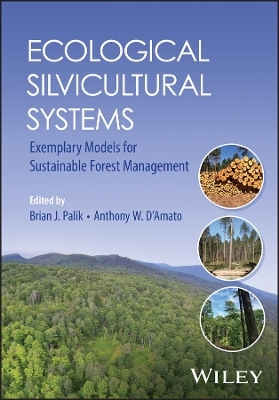
Ecological silvicultural systems
John Wiley & Sons Inc (Verlag)
978-1-119-89090-4 (ISBN)
Brian J. Palik, PhD, is a research ecologist with the United States Department of Agriculture Forest Service, Northern Research Station, Grand Rapids, MN, USA. He has published widely on the ecological sustainability of managed forests and related fields. Anthony W. D’Amato, PhD, is Professor of Silviculture and Applied Forest Ecology and Director of the Forestry Program at the University of Vermont, USA. He has researched and published extensively on long-term forest dynamics and silvicultural strategies to foster adaptive forests.
Preface: Why Ecological Silviculture?AcknowledgementsChapter 1. The Context of Ecological silvicultureAuthors: Brian J. Palik, Anthony W. D'AmatoChapter 2. Ecological silviculture for western Great Lakes red pine ecosystems.Author: Brian J. Palik, Anthony W. D'AmatoChapter 3. Ecological silviculture for northern hardwood ecosystems of northeastern U.S.Author: Anthony W. D'AmatoChapter 4. Ecological silviculture of Douglas-fir-western hemlock forests.Author: Abraham Wheeler, Jerry F. Franklin, Stephanie J. WessellChapter 5. Ecological silviculture for longleaf pine woodlands in the southeastern U.S.Author: Steven B Jack, Benjamin O Knapp, R Kevin McIntyreChapter 6. Ecological silviculture of southeastern US pine-oak forestsAuthor: Justin L. Hart, J. Davis Goode, Daniel C. DeyChapter 7. Ecological silviculture for conifer wetlands in the western Lakes StatesAuthor: Marcella A. Windmuller-Campione, Laura F. Reuling, Robert A. Slesak, Randy K. KolkaChapter 8. Ecological silviculture for southern Appalachian hardwood forestsAuthor: Jodi A. Forrester, Tara L. Keyser, David K. SchnakeChapter 9. Ecological silviculture for yellow birch-conifer mixedwoods in eastern CanadaAuthor: Patricia Raymond, Daniel DumaisChapter 10. Ecological silviculture for boreal black spruce in CanadaAuthor: Miguel Montoro Girona, Martin Alcala Pajares, and Maxence MartinChapter 11. Ecological silviculture for Acadian mixedwood forestsAuthor: Robert S. SeymourChapter 12. Ecological silviculture for Sierra Nevada conifer forestsAuthor: Robert A. YorkChapter 13. Ecological silviculture for aspen mixedwoods in western CanadaAuthor: S. Ellen Macdonald, Phil G. Comeau, Charles A. Nock, Brad D. PinnoChapter 14. Ecological silviculture for North American interior dry pine forestsAuthor: Andrew J. Larson, Derek J. ChurchillChapter 15. Ecological silviculture for North American temperate rainforestsAuthor: Justin S. Crotteau, William J. Beese, John-Pascal Berrill, Robert L. Deal, Constance A. Harrington, Kellen N. NelsonChapter 16. Ecological silviculture for Central Hardwood forests and woodlands of the US.Author: Miranda T. Curzon, John M. KabrickChapter 17. Ecological silviculture for Fennoscandian Scots pine ecosystemsAuthor: Timo Kuuluvainen and Timo PukkalaChapter 18. Ecological silviculture for mountain ash forests of AustraliaAuthor: David B. LindenmayerChapter 19. Ecological silviculture for central European beech dominated forestsAuthor: Thomas A. Nagel, Miroslav Svoboda, Lucie Vítková, Dusan Ro?enbergarChapter 20. Ecological silviculture for Chilean temperate rainforestsAuthor: Pablo J. Donoso, Daniel P. SotoChapter 21. The place of ecological silviculture, now and in the future.Author: Anthony W. D'Amato, Brian J. PalikIndex. Indexing terms, species, geographic locations, etc.
| Erscheinungsdatum | 14.11.2023 |
|---|---|
| Zusatzinfo | Illustrationen |
| Verlagsort | New York |
| Sprache | englisch |
| Maße | 180 x 253 mm |
| Gewicht | 652 g |
| Einbandart | kartoniert |
| Themenwelt | Naturwissenschaften ► Geowissenschaften ► Geologie |
| Weitere Fachgebiete ► Land- / Forstwirtschaft / Fischerei | |
| Schlagworte | Agriculture • Angewandte Ökologie • Applied Ecology • Biowissenschaften • Environmental Management, Policy & Planning • Environmental Studies • forestry • Forstwirtschaft • Landwirtschaft • Life Sciences • Umweltforschung • Umweltmanagement • Umweltmanagement, Politik u. -Planung |
| ISBN-10 | 1-119-89090-X / 111989090X |
| ISBN-13 | 978-1-119-89090-4 / 9781119890904 |
| Zustand | Neuware |
| Informationen gemäß Produktsicherheitsverordnung (GPSR) | |
| Haben Sie eine Frage zum Produkt? |
aus dem Bereich


